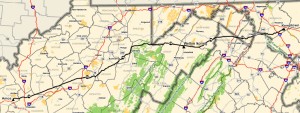PATH transmission line WITHDRAWN!!!!
February 28th, 2011
The application for the Potomac Appalachian Transmission Highline, PATH, has been withdrawn. Notice was just sent out, not long after PJM issued a press release saying that PATH was “delayed.”
And here’s the one we’ve been waiting for, Potomac Edison’s Notice of Withdrawal (that didn’t take long!):
I’m looking on the PJM website, and can’t find the 2010 RTEP, so I call the number on the bottom of the Press Release, 866-756-6397, wanting to know where the 2010 RTEP is (one of the attorneys on the Susquehanna-Roseland line had asked about that, and I was stunned I couldn’t find it!!!), and when the 2011 RTEP is due out. No one can help, they’re in a meeting, “anyone that could help you is in a meeting.” Someone will call back… Uh-huh… right…
What they say is what we’ve been saying for how long?
PJM annually reviews its transmission expansion plans. A preliminary analysis suggests that the need for the line has moved further into the future. Therefore, the PJM Board has decided to hold the PATH project in abeyance in the 2011 Regional Transmission Expansion Plan (RTEP). The preliminary analysis used the most current economic forecasts, demand response commitments and potential new generation.
…
Over the last two years, the recession and the dramatic change in the economic outlook caused PJM to forecast lower growth in the use of electricity. Growth in the use of electricity correlates with economic growth. The forecasted slower growth rate likely will delay the need for the line.
So now, how to find that 2010 RTEP???
Susquehanna-Roseland Reply Briefs!
January 7th, 2010
Susquehanna-Roseland Reply Briefs were due yesterday — I’m representing Stop the Lines.
So it’s nap time today…
Here they are!
STL – Certification & Exhibits
Municipal Intervenors Reply Brief
Environmental Intervenors Reply Brief
Environmental Intervenors – Certification
Environmental Intervenors – Exhibits
Montville Board of Education Reply Brief
Hmmmmmmmmm… I don’t see anything from Exelon…
Happy reading! Dig some of the exhibits, like the Motion to Withdraw from PATH-VA, the PJM 2010 Load Forecast (which shows demand has been down down down since the peak of 2006), and the sensitivity analysis that shot down PATH in Virginia!
PATH transmission withdraws application
December 23rd, 2009
They’re withdrawing their application, saying they want them timed together — if so, why withdraw, and not just ask for suspension? “It keeps the blood flowing” they say, but I’d say it keeps the blood boiling. Why not just admit it — it’s not needed, and there’s no way they can prove, and now they tacitly admit they can’t even CLAIM it’s needed.
A decent article from the Leesburg Journal:
PATH Seeks To Withdraw, Suspend Richmond Hearings
By Margaret Morton
(Created: Tuesday, December 22, 2009 7:48 PM EST)
Motions to Dismiss PATH Transmission Application
October 28th, 2009
HA! The Commission staff from both the state of Virginia and the state of West Virginia have both brought Motions to Dismiss the PATH transmission application. Hilarious! About time! PATH is the Potomac-Appalachian Transmission Highline.
Seems there’s a theme goin’ on…
Maryland rejects PATH transmission line
September 10th, 2009
Potomac Appalachian Transmission Highline
The Washington Post says:
Allen Staggers — Ja, I’ll bet he sure does now!!!
***********************************
Yes, “transmission from hell” is everywhere… here are some sites for opponents of the PATH line:
Pennsylvania Land Trust Association
The Applicants who just got slapped up by Maryland:
And here’s the TOADIES for PATH – dig the logo, compare with PATH:
***************************************
Maryland’s Public Service Commission seems, indeed, to be dedicated to the public! It has rejected the Potomac-Appalachian Transmission Highline, PATH, transmission project application.
The Baltimore Sun gets it:
PSC right to reject power line
In the Frederick News-Post:
Maryland Commission Rejects PATH Transmission Application
Posted Thursday, September 10, 2009
“We see it as a procedural decision based on interpretation of Maryland law,” Colafella said.
Allegheny and AEP will continue to pursue the line in Virginia and West Virginia, he said.


